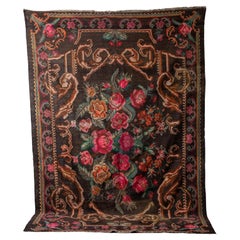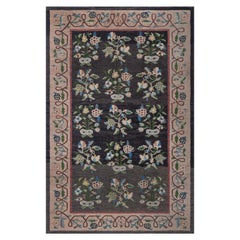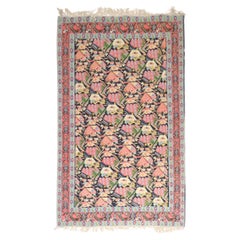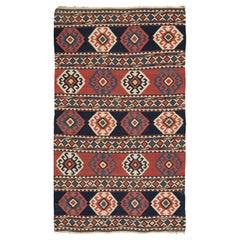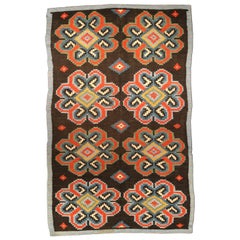Early 20th Century Russian and Scandinavian Rugs
1
447
to
46
418
28
447
447
447
36
15
12
10
2
2
2
1
1
1
5
239
1,947
1,462
447
1,136
124
221
21
65
39
47
85
93
44
6
7
Width
to
Length
to
445
439
200
4
2
217
114
105
99
83
9
5
3
2
2
Period: Early 20th Century
Bessarabian Kilim Rug, c.1920s
Located in Savannah, GA
A Bessarabian Kilim rug, circa 1920s.
76 by 117 inches
Category
Moldovan Other Vintage Early 20th Century Russian and Scandinavian Rugs
Materials
Wool
Antique Bessarabian Rug
Located in New York, NY
Antique Bessarabian Rug
Size: 6'3" × 10'0" (190 × 304 cm)
This Early 20th Century traditional handwoven Russian Bessarabian rug has a charcoal-black field with rows of polychrome flo...
Category
Russian Bessarabian Early 20th Century Russian and Scandinavian Rugs
Materials
Wool
Vintage Scandinavian Flat-Weave Wool Rug Woven Initials & Date to Edge 'Io 1928'
Located in New York, NY
Vintage Scandinavian flat-weave wool rug. Woven initials and date to edge 'IO 1928'
Size: 7'9" × 11'6" (236 × 350 cm)
Vintage Swedish rug, circa 1928. This flat-woven vintage area ru...
Category
Swedish Early 20th Century Russian and Scandinavian Rugs
Materials
Wool
Zabihi Collection Antique Persian Senneh Kilim
Located in New York, NY
An authentic 19th century Persian Senneh Kilim. Untouched and kept in it's original state for over a century. has a tropical feel to it
Senneh Kilims were finely woven in slit tapes...
Category
Persian Kilim Early 20th Century Russian and Scandinavian Rugs
Materials
Wool
Antique Caucasian Shirvan Kilim 55390
Located in WEST HOLLYWOOD, CA
Rug Number
55390
Size
6' 0" X 10' 5"
Design
Kilim
Collection
Antique/Vintage, Flat Weaves
Material
Wool
Texture
Flat Weave
Origin
Russia
Age
Antique/Vintage
Category
Russian Vintage Early 20th Century Russian and Scandinavian Rugs
Materials
Wool
Early 20th Century Russian Bessarabian Rug
Located in New York, NY
Authentic Early 20th century Russian Bessarabian carpet
Size: 5'5" × 8'10" (165 × 269 cm)
An early 20th century Russian Bessarabian rug, the brown field with a Primitive overall desi...
Category
Russian Bessarabian Early 20th Century Russian and Scandinavian Rugs
Materials
Wool
Authentic Botanic Russian Bessarabian Handmade Rug
Located in New York, NY
Authentic Botanic Russian Bessarabian handmade wool rug
Size: 9'0" × 14'3" (274 × 434 cm)
An early 20th century Russian Bessarabian antique rug, the maize field with rows of subtle r...
Category
Russian Bessarabian Early 20th Century Russian and Scandinavian Rugs
Materials
Wool
Antique Russian Shirvan Rug 31283
Located in WEST HOLLYWOOD, CA
Rug Number
31283
Size
4' 10" X 6' 3"
Design
Shirvan
Collection
Antique/Vintage
Material
Wool
Texture
Pile Weave
Origin
Russia
Age
Antique/Vintage
Category
Russian Antique Early 20th Century Russian and Scandinavian Rugs
Materials
Wool
Antique Russian Shirvan Runner
Located in WEST HOLLYWOOD, CA
Rug Number
28021
Size
3' 2" X 14' 2"
Design
Shirvan
Collection
Antique/Vintage
Material
Wool
Texture
Pile Weave
Origin
Russia
Age
Antique/Vintage
Category
Russian Antique Early 20th Century Russian and Scandinavian Rugs
Materials
Wool
Antique Caucasian Shirvan Area Rug
Located in New York, NY
Shirvan rug, floor covering handmade in the Shirvan region of Azerbaijan in the southeastern Caucasus. With the exception of a group of rugs woven in the vicinity of Baku, most Shirv...
Category
Russian Antique Early 20th Century Russian and Scandinavian Rugs
Materials
Wool
Vintage Swedish Bold Abstract Design Carpet
Located in New York, NY
Vintage Swedish Bold Abstract Design Carpet
Size: 9'9" × 12'8" (297 × 386 cm)
Style: Abstract, Botanic, Geometric, Scandinavian
An early 20th century Swedish carpet, the field having...
Category
Swedish Early 20th Century Russian and Scandinavian Rugs
Materials
Wool
Early 20th Century Russian Bessarabian Handmade Rug
Located in New York, NY
Early 20th century Russian Bessarabian floral handmade wool rug
Size: 7'10" × 9'2" (238 × 279 cm)
An early 20th century Russian Bessarabian antique rug, the greenish ivory field with...
Category
Russian Bessarabian Early 20th Century Russian and Scandinavian Rugs
Materials
Wool
Antique Karabagh Rug
Located in New York, NY
Antique Karabagh rug
Size: 5'2" × 10'5" (157 × 317 cm)
A Russian Karabagh rug dating back to circa 1900. The main field displays abstract flower-heads and palmettes enclosed with a g...
Category
Russian Early 20th Century Russian and Scandinavian Rugs
Materials
Wool
Zabihi Collection Goddess Queen Persian Pictorial Rug
Located in New York, NY
An early 20th century Persian pictorial rug what looks to be some sort of goddess queen
Measures: 2'1'' x 4'3''
Category
Persian Islamic Early 20th Century Russian and Scandinavian Rugs
Materials
Wool
Swedish Kilim Vintage By IS (Ingegerd Silow) 1916-2005
Located in Ferrara, IT
This is a Vintage Swedish kilim woven circa 1920-1950 and it measures 230 X 164 cm. The design of this kilim is attributed to Ingegerd Silow, one of the most influential designers in...
Category
Scandinavian Scandinavian Modern Early 20th Century Russian and Scandinavian Rugs
Materials
Wool
Early 20th Century Chinese Art Deco Carpet ( 9' x 14'3" - 275 x 435 )
Located in New York, NY
Early 20th Century Chinese Art Deco Carpet ( 9' x 14'3" - 275 x 435 )
Category
Chinese Art Deco Vintage Early 20th Century Russian and Scandinavian Rugs
Materials
Wool
Hamadan Vintage Olive Green Rug Circa 1920s
Located in New York, NY
Overwashed, modern aesthetic, faded olive Hamadan rug (Persian) with beautiful allover field
Category
Early 20th Century Russian and Scandinavian Rugs
Materials
Wool
Antique Swedish Tapestry Geometric 4x6 130cm x 186cm
Located in New York, NY
Antique Swedish Tapestry 4x6 4'3" x 6'1" 130cm x 186cm
About Us~
Welcome to Antique Rug Collection. Your #1 Source for handmade Antique Rugs...
Category
Scandinavian Vintage Early 20th Century Russian and Scandinavian Rugs
Materials
Wool
1920s Antique Needlepoint Rug - 6'7'' X 6'5''
Located in Los Angeles, US
Needlepoint rugs were created using the traditional needlework weaving technique that is used to make everyday items from furniture to carpets and artwork. However, it has a fascinating history both as a hobby and as an industry. When many people think of carpets, they think of pile carpets or flat weave kilims, but needlepoint has also been used to create beautiful carpets. These carpets are durable and an important part of carpet history.
Archaeologists and scholars consider the roots of needlepoint to have been around 1500 BC. They consider the first needlepoint to include the fine diagonal stitches that were used to sew tents together by the ancient Egyptians. The art eventually evolved into tapestry weaving. However, a tapestry weaving differs significantly from needlepoint in that it uses a loom and vertical warp.
Tapestry weaving is closer to the weaving of kilims and pile rugs than canvas work. However, some still include tapestry weaving in the category of needlepoint because of the fine work that appeared during the late Renaissance. It can have a similar appearance to the untrained eye. Technically, tapestry weaving and needlepoint are not the same, and they do not use the same technique.
The first actual needlepoint rugs and needle-points began to appear in the late Renaissance. Needlepoint is worked by creating stitches on a stiff canvas. The canvas is typically made from jute or linen and is quite durable. Pieces from the Renaissance were used to cover footstools, chairs, pillows, bed headboards, and other furnishings. They were also used as table coverings and wall coverings. You could also find them on many small items such as purses, shoes, and various adornments for clothing.
During the Renaissance, the craft reached a high level of skill, and the designs became incredibly detailed and realistic. They mimicked many of the subjects and styles of famous paintings of the time. They created florals, still life designs, scenes, and geometric tiled pieces. Some of them mimicked the designs found in Persian Carpets.
Needlepoint reached its peak popularity in the 19th century when it was considered a proper occupation for a lady. Needlepoint and embroidery held a similar place in societal status at the time. During this time, the work became finer, with some of the canvas reaching a high level of detail. The level of detail is determined by counting the number of mesh in an inch. During this time petit point by French needlewomen could have a mesh count as high as 45 mesh. This allowed women to create highly intricate designs with incredible levels of detail.
It is possible to find many antique pieces of needlepoint besides rugs. Needlepoint rugs were popular in France and Spain, where the technique was adapted to create highly intricate designs that mimicked the designs in architecture and fashion. They were popular because they were durable, and it could be fashioned into a variety of items. The canvases themselves were durable, and the wool that they used was also strong, which means that many of the pieces were able to withstand daily use. We have many artifacts that have survived from this time period.
Needlepoint rugs are important collectibles because they are different from the pile rugs and kilims that are typically found on the market. Needlepoint carpets are special because they take many hours to create, especially larger works. Needlepoint pieces of any type became popular throughout Europe during the 19th century. It is still a popular hobby today, but perhaps one of the most interesting stories is that of the Portuguese needlewomen of Arraiolos.
The story of these women and their beautiful carpets begins in 1492. Needlepoint was a popular occupation in Spain, which had a large population of Moors and Jews. They were an integral part of Spanish culture. However, in 1492, Queen Isabella of Spain issued a proclamation that gave these ethnic groups the order to pack their bags and board ships headed...
Category
Other Vintage Early 20th Century Russian and Scandinavian Rugs
Materials
Wool
Antique Russian Gharabagh Circa 1900s
Located in WEST HOLLYWOOD, CA
Rug Number
28430
Size
3' 8" X 5' 7"
Design
Gharabagh
Collection
Antique/Vintage
Material
Wool
Texture
Pile Weave
Origin
Russia
Age
Antique/Vintage
Category
Russian Antique Early 20th Century Russian and Scandinavian Rugs
Materials
Wool
Floral Medallion Antique Sarouk Persian Rug Circa 1920
Located in New York, NY
Floral Medallion Antique Sarouk Persian Rug Circa 1920
Category
Early 20th Century Russian and Scandinavian Rugs
Materials
Wool
Zabihi Collection Mini Size Persian Pictorial Rug
Located in New York, NY
An early 20th century Persian pictorial rug from the city of Isfahan
Measures: 1'7'' x 1'10''.
Category
Persian Islamic Early 20th Century Russian and Scandinavian Rugs
Materials
Wool
Antique Samarkand Rug 1900 -8'4'' X 5'8''
Located in Los Angeles, US
Antique Uzbek Samarkand Rug 8'4'' X 5'8'', tribal and traditional, antique and vintage, wool on cotton foundation
Category
Uzbek Tribal Antique Early 20th Century Russian and Scandinavian Rugs
Materials
Wool, Cotton
Antique Samarkand Rug 1900 -10'7'' X 5'6''
Located in Los Angeles, US
Antique Uzbek Khotan Samarkand Rug 10'7'' X 5'6''. tribal and traditional, antique and vintage, wool on cotton foundation
Category
Uzbek Tribal Antique Early 20th Century Russian and Scandinavian Rugs
Materials
Wool, Cotton
Antique Samarkand Rug 1900 -8'7'' X 4'8''
Located in Los Angeles, US
Antique Samarkand Rug 1900 -8'7'' X 4'8''
Category
Uzbek Tribal Antique Early 20th Century Russian and Scandinavian Rugs
Materials
Wool, Cotton
Antique Samarkand Rug 1900 -9'1'' X 4'10''
Located in Los Angeles, US
Antique Uzbek Samarkand Rug 9'1'' X 4'10'', tribal and traditional, antique and vintage, wool on cotton foundation
Category
Uzbek Tribal Antique Early 20th Century Russian and Scandinavian Rugs
Materials
Wool, Cotton
Antique Samarkand Rug 1900 -8'6'' X 5'5''
Located in Los Angeles, US
Antique Uzbek Samarkand Rug 8'6'' X 5'5'', tribal and traditional, antique and vintage, wool on cotton foundation
Category
Uzbek Tribal Antique Early 20th Century Russian and Scandinavian Rugs
Materials
Wool, Cotton
Antique Samarkand Rug 1900 -8'8'' X 4'10''
Located in Los Angeles, US
Antique Uzbek Samarkand Rug 8'8'' X 4'10'', tribal and traditional, antique and vintage, wool on cotton foundation
Category
Uzbek Tribal Antique Early 20th Century Russian and Scandinavian Rugs
Materials
Wool, Cotton
Antique Samarkand Rug 1900 -10'10'' X 5'6''
Located in Los Angeles, US
Antique Uzbek Samarkand Rug 10'10'' X 5'6''.tribal and traditional, antique and vintage, wool on cotton foundation
Category
Uzbek Tribal Antique Early 20th Century Russian and Scandinavian Rugs
Materials
Wool, Cotton
Antique Samarkand Rug 1900 -9'7'' X 5'3''
Located in Los Angeles, US
Antique Uzbek Samarkand Rug 9'7'' X 5'3'', tribal and traditional, antique and vintage, wool on cotton foundation
Category
Uzbek Tribal Antique Early 20th Century Russian and Scandinavian Rugs
Materials
Cotton
Antique Samarkand Rug 1900 -8'10'' X 4'7''
Located in Los Angeles, US
Antique Uzbek Samarkand Rug 8'10'' X 4'7'', tribal and traditional, antique and vintage, wool on cotton foundation
Category
Uzbek Tribal Antique Early 20th Century Russian and Scandinavian Rugs
Materials
Wool, Cotton
Antique Samarkand Rug 1900 -11'5'' X 5'10''
Located in Los Angeles, US
Antique Uzbek Samarkand Rug 11'5'' X 5'10'', tribal and traditional, antique and vintage, wool on cotton foundation
Category
Uzbek Tribal Antique Early 20th Century Russian and Scandinavian Rugs
Materials
Wool, Cotton
Rug ‘Ståndaren’ designed by Märta Måås-Fjetterström for MMF, Sweden, 1928
Located in Stockholm, SE
Rug ‘Ståndaren’ designed by Märta Måås-Fjetterström for MMF,
Sweden, 1928.
Wool.
Signed.
This example was woven before 1942. The pattern "Ståndaren" was designed for the world-fam...
Category
Swedish Mid-Century Modern Vintage Early 20th Century Russian and Scandinavian Rugs
Materials
Wool
Antique Sumak Rug
Located in Los Angeles, US
Soumak rugs (also spelled Sumak) – This construction technique produces a flat-weave rug that is thick, strong and exceptionally durable. Unlike kilims, Soumak rugs are not reversibl...
Category
Other Antique Early 20th Century Russian and Scandinavian Rugs
Materials
Wool, Cotton
Striking Bessarabian Kilim, c. 1920s
Located in London, GB
The tradition of Bessarabian kilim weaving dates to the later period of Ottoman rule over the Eastern Balkans – broadly, the territory now covered by Bulgaria and Moldova – and is kn...
Category
Balkan Bessarabian Vintage Early 20th Century Russian and Scandinavian Rugs
Materials
Wool
Antique Collectible Woolen Needlework
Located in Los Angeles, US
Needlepoint rugs were created using the traditional needlework weaving technique that is used to make everyday items from furniture to carpets and artwork. However, it has a fascinating history both as a hobby and as an industry. When many people think of carpets, they think of pile carpets or flat weave kilims, but needlepoint has also been used to create beautiful carpets. These carpets are durable and an important part of carpet history.
Archaeologists and scholars consider the roots of needlepoint to have been around 1500 BC. They consider the first needlepoint to include the fine diagonal stitches that were used to sew tents together by the ancient Egyptians. The art eventually evolved into tapestry weaving. However, a tapestry weaving differs significantly from needlepoint in that it uses a loom and vertical warp.
Tapestry weaving is closer to the weaving of kilims and pile rugs than canvas work. However, some still include tapestry weaving in the category of needlepoint because of the fine work that appeared during the late Renaissance. It can have a similar appearance to the untrained eye. Technically, tapestry weaving and needlepoint are not the same, and they do not use the same technique.
The first actual needlepoint rugs and needle-points began to appear in the late Renaissance. Needlepoint is worked by creating stitches on a stiff canvas. The canvas is typically made from jute or linen and is quite durable. Pieces from the Renaissance were used to cover footstools, chairs, pillows, bed headboards, and other furnishings. They were also used as table coverings and wall coverings. You could also find them on many small items such as purses, shoes, and various adornments for clothing.
During the Renaissance, the craft reached a high level of skill, and the designs became incredibly detailed and realistic. They mimicked many of the subjects and styles of famous paintings of the time. They created florals, still life designs, scenes, and geometric tiled pieces. Some of them mimicked the designs found in Persian Carpets.
Needlepoint reached its peak popularity in the 19th century when it was considered a proper occupation for a lady. Needlepoint and embroidery held a similar place in societal status at the time. During this time, the work became finer, with some of the canvas reaching a high level of detail. The level of detail is determined by counting the number of mesh in an inch. During this time petit point by French needlewomen could have a mesh count as high as 45 mesh. This allowed women to create highly intricate designs with incredible levels of detail.
It is possible to find many antique pieces of needlepoint besides rugs. Needlepoint rugs were popular in France and Spain, where the technique was adapted to create highly intricate designs that mimicked the designs in architecture and fashion. They were popular because they were durable, and it could be fashioned into a variety of items. The canvases themselves were durable, and the wool that they used was also strong, which means that many of the pieces were able to withstand daily use. We have many artifacts that have survived from this time period.
Needlepoint rugs are important collectibles because they are different from the pile rugs and kilims that are typically found on the market. Needlepoint carpets are special because they take many hours to create, especially larger works. Needlepoint pieces of any type became popular throughout Europe during the 19th century. It is still a popular hobby today, but perhaps one of the most interesting stories is that of the Portuguese needlewomen of Arraiolos.
The story of these women and their beautiful carpets begins in 1492. Needlepoint was a popular occupation in Spain, which had a large population of Moors and Jews. They were an integral part of Spanish culture. However, in 1492, Queen Isabella of Spain issued a proclamation that gave these ethnic groups the order to pack their bags and board ships headed...
Category
Other Antique Early 20th Century Russian and Scandinavian Rugs
Materials
Wool
1920s Antique Floral Samarkand Rug
Located in Los Angeles, US
Antique Samarkand Rugs: The desert oasis of Khotan was an important stop on the Silk Road. The people of Khotan were expert carpet weavers who produced high quality antique rugs and ...
Category
Other Vintage Early 20th Century Russian and Scandinavian Rugs
Materials
Wool, Cotton
1900s Antique Khotan Samarkand Rug
Located in Los Angeles, US
Antique Samarkand Rugs: The desert oasis of Khotan was an important stop on the Silk Road. The people of Khotan were expert carpet weavers who produced high quality antique rugs and ...
Category
Other Antique Early 20th Century Russian and Scandinavian Rugs
Materials
Wool, Cotton
Märta Måås Fjetterström 'Gul våd' Wall Tapestry
Located in Waalwijk, NL
Märta Måås Fjetterström for MMF, ‘Gul våd’ wall tapestry, wool, linen, Sweden, design 1924, executed before 1942.
This handwoven Gul våd’ tapestry is designed by one of the most in...
Category
Swedish Scandinavian Modern Vintage Early 20th Century Russian and Scandinavian Rugs
Materials
Wool, Linen
1900 Antique Bessarabian Flat Weave Kilim Rug
Located in Los Angeles, US
Beautiful Collection of Romanian Antique Bessarabian Kilims and Rugs
Antique Bessarabian Rugs / Kilims in both pile and tapestry weaving technique are some of the more beautiful carpets to have been produced in Europe. Many of the Bessarabian Kilims were woven around the mid to late 19th century, though some do date back to the 18th century as well. This production that carried into the early twentieth century under late Ottoman Turkish rule in an area corresponding to modern Bulgaria and Romania, they stand right on the cusp of European and Oriental carpet weaving. Many of the designs are floral patterns made in a naturalistic western style utilizing brown or black ground, not unlike certain Karabaghs from the Caucauses. But others, particularly flat weaves, reflect the tradition of Turkish kilims from nearby Anatolia, although in a distinctive Bessarbian palette. In either case they are supremely decorative rugs.
History Of Antique Flat Woven Bessarabian Kilim Rugs from Romania
Bessarabian Kilims and carpets are flat woven rugs that originate in the Russian provinces of the Ukraine and Moldova in the late 1800’s to the early 1900’s. While most carpet experts will classify the flat woven rugs as Bessarabian they will often refer to the knotted pile carpets as Ukrainian.
The Bessarabian carpets differ from antique Persian carpets in many ways. For example, unlike Persian carpets, Bessarabian rugs cannot be classified to a region according to the way the rugs were woven. Their weaves provide indications regarding the area for which they were created rather than for their classification. The markets these antique rugs were designed for could have fallen into different categories such as a rural market or an urban one. But all other attributes were dismissed and all the Romani made area rugs and carpets are referred to as Bessarabian instead.
Antique Romanian Bessarabian kilims are ornate and they come in a variety of designs as well color combinations. It’s not uncommon for some Bessarabian kilims to be more floral while others may feature more geometric patterns. Bessarabian carpets are made on carpet weaving looms similar to the ones used to make the French Aubusson rugs.
These looms are wooden, and the rugs are flat woven / kilims. The best of these rug types were created in the 1700’s. The Russian Imperial Tapestry Factory was where these Romanian rugs were made, and the factory was created by none other than Peter the Great. He established the Russian Imperial Tapestry Factory following his return from England and France. He was inspired to create the factory after being in awe of the splendid Aubusson carpets, Savonnerie rugs, and Axminster carpets he saw while abroad.
The beautiful carpets he admired while in Europe had already caught the eyes of his Russian contemporaries, and importing them was triggering a financial drain for the Russian treasury. For this reason, the Russian Imperial Tapestry Factory was used as a location for copying the French and English carpets Peter the Great and the Russian nobility desired.
Demand for these lavishly luxurious rugs grew, and additional factories were created in villages. This region is from where these rugs got the name Bessarabian. The region is divided between two territories: the Republic of Moldova and Romania. Bessarabian rug weavers were country people who had a country taste. Though they were tasked with replicating the elaborate motifs of the European rugs, they added their own unique country’s flair to their borrowed rug patterns and designs. This more folksy or traditional approach to the European patterns...
Category
Asian Neoclassical Antique Early 20th Century Russian and Scandinavian Rugs
Materials
Wool
Antique Samarkand Rug with Animal Print Design
Located in Los Angeles, US
Antique Samarkand Rugs: The desert oasis of Khotan was an important stop on the Silk Road. The people of Khotan were expert carpet weavers who produced high quality antique rugs and ...
Category
Asian Other Antique Early 20th Century Russian and Scandinavian Rugs
Materials
Wool, Cotton
1920s Antique Samarkand Rug
Located in Los Angeles, US
Antique Samarkand Rugs: The desert oasis of Khotan was an important stop on the Silk Road. The people of Khotan were expert carpet weavers who produced high quality antique rugs and ...
Category
Other Vintage Early 20th Century Russian and Scandinavian Rugs
Materials
Wool, Cotton
1900s Antique Decorative Khotan Samarkand Rug-6'10'' X 4'6''
Located in Los Angeles, US
Antique Decorative Khotan Samarkand Rug 6'10'' X 4'6'', tribal and traditional, wool on cotton foundation, vegetable dyes, design and colour combination inspired by the nature they w...
Category
Asian Tribal Antique Early 20th Century Russian and Scandinavian Rugs
Materials
Wool, Cotton
Antique Khotan Samarkand Rug-7'5'' X 4'5''
Located in Los Angeles, US
Up for sale is an Antique Khotan Samarkand Rug, from Uzbekistan, circa the 1900s.
Category
Uzbek Tribal Antique Early 20th Century Russian and Scandinavian Rugs
Materials
Wool, Cotton
Antique Needlework Animal Print Design Rug
Located in Los Angeles, US
Needlepoint rugs were created using the traditional needlework weaving technique that is used to make everyday items from furniture to carpets and artwork. However, it has a fascinat...
Category
Asian Other Antique Early 20th Century Russian and Scandinavian Rugs
Materials
Cotton
Antique 1920 Samarkand Rug
Located in Los Angeles, US
Antique Samarkand Rugs: The desert oasis of Khotan was an important stop on the Silk Road. The people of Khotan were expert carpet weavers who produced high quality antique rugs and ...
Category
Other Vintage Early 20th Century Russian and Scandinavian Rugs
Materials
Wool, Cotton
1920s Vintage Flat Weave Decorative Soumak Rug
Located in Los Angeles, US
oumak rugs (also spelled Sumak) – This construction technique produces a flat-weave rug that is thick, strong and exceptionally durable. Unlike kilims, Soumak rugs are not reversible...
Category
Tribal Vintage Early 20th Century Russian and Scandinavian Rugs
Materials
Wool
Antique Bessarabian Floral Rug
Located in Los Angeles, US
Antique Bessarabian Rugs / Kilims in both pile and tapestry weaving technique are some of the more beautiful carpets to have been produced in Europe. Many of the Bessarabian Kilims w...
Category
Other Antique Early 20th Century Russian and Scandinavian Rugs
Materials
Wool, Cotton
1920s Antique Needlepoint Runner
Located in Los Angeles, US
Needlepoint rugs were created using the traditional needlework weaving technique that is used to make everyday items from furniture to carpets and artwork. However, it has a fascinat...
Category
Other Vintage Early 20th Century Russian and Scandinavian Rugs
Materials
Wool, Cotton
Antique Handmade Samarkand Rug Ca.1900 - 8'7'' X 5'4''
Located in Los Angeles, US
Antique Samarkand Rugs: The desert oasis of Khotan was an important stop on the Silk Road. The people of Khotan were expert carpet weavers who produced high quality antique rugs and ...
Category
Asian Tribal Antique Early 20th Century Russian and Scandinavian Rugs
Materials
Wool, Cotton
1920s Antique Needlepoint Runner
Located in Los Angeles, US
The technique for creating needlepoint rugs and other objects made from needlepoint has remained unchanged since its beginnings in the 17th century. It all begins with a canvas with ...
Category
Other Vintage Early 20th Century Russian and Scandinavian Rugs
Materials
Wool
19th Century Authentic Caucasian Rug
Located in Los Angeles, US
The antique Caucasian rugs get their name from the area in which they were made – the Caucasus. The Caucasus is a region that produces distinctive rugs since the end of the 18th cent...
Category
Tribal Antique Early 20th Century Russian and Scandinavian Rugs
Materials
Wool
Antique Oushak Rug 10.8x9.2
Located in Los Angeles, US
Antique Turkish Oushak rugs have been woven in Western Turkey since the beginning of the Ottoman period. Historians attributed to them many of the great masterpieces of early Turkish...
Category
Other Antique Early 20th Century Russian and Scandinavian Rugs
Materials
Wool, Cotton
1900 Antique Botanical Style Bessarabian Rug
Located in Los Angeles, US
Antique Bessarabian Rugs / Kilims in both pile and tapestry weaving technique are some of the more beautiful carpets to have been produced in Europe. Many of the Bessarabian Kilims w...
Category
Other Vintage Early 20th Century Russian and Scandinavian Rugs
Materials
Wool, Cotton
1900 Antique Tribal Khotan Samarkand Rug
Located in Los Angeles, US
Antique Samarkand Rugs: The desert oasis of Khotan was an important stop on the Silk Road. The people of Khotan were expert carpet weavers who produced high quality antique rugs and ...
Category
Other Antique Early 20th Century Russian and Scandinavian Rugs
Materials
Wool, Cotton
Antique Floral Bessarabian Kilim Rug
Located in Los Angeles, US
Antique Floral Bessarabian Kilim Rug
Category
Other Early 20th Century Russian and Scandinavian Rugs
Materials
Wool, Cotton
Antique Oushak Rug 11.8x10.0
Located in Los Angeles, US
Antique Turkish Oushak rugs have been woven in Western Turkey since the beginning of the Ottoman period. Historians attributed to them many of the great masterpieces of early Turkish...
Category
Other Antique Early 20th Century Russian and Scandinavian Rugs
Materials
Wool, Cotton
Antique Samarkand Rug with Animal Print Design
Located in Los Angeles, US
Antique Samarkand Rugs: The desert oasis of Khotan was an important stop on the Silk Road. The people of Khotan were expert carpet weavers who produced high quality antique rugs and ...
Category
Asian Other Antique Early 20th Century Russian and Scandinavian Rugs
Materials
Wool, Cotton
Recently Viewed
View AllMore Ways To Browse
Swedish Double Sided Carpet
Swedish Rug Double Sided
Finnish Rya
Finland Rya
Swedish Hanging Rugs
Swedish Rug Red And White
Ingrid Swedish Rug
Mmf Flat
Swedish Rug By M A
Victoria Rug
Finnish Rya Rug
Retro 70s Rug
Finnish Rya Rugs
Half Circle Bar
Antique Russian Bessarabian Rug
Vintage Rugs 6ft X 8ft
Swedish Kilim Signed
Vintage Fur Rug
